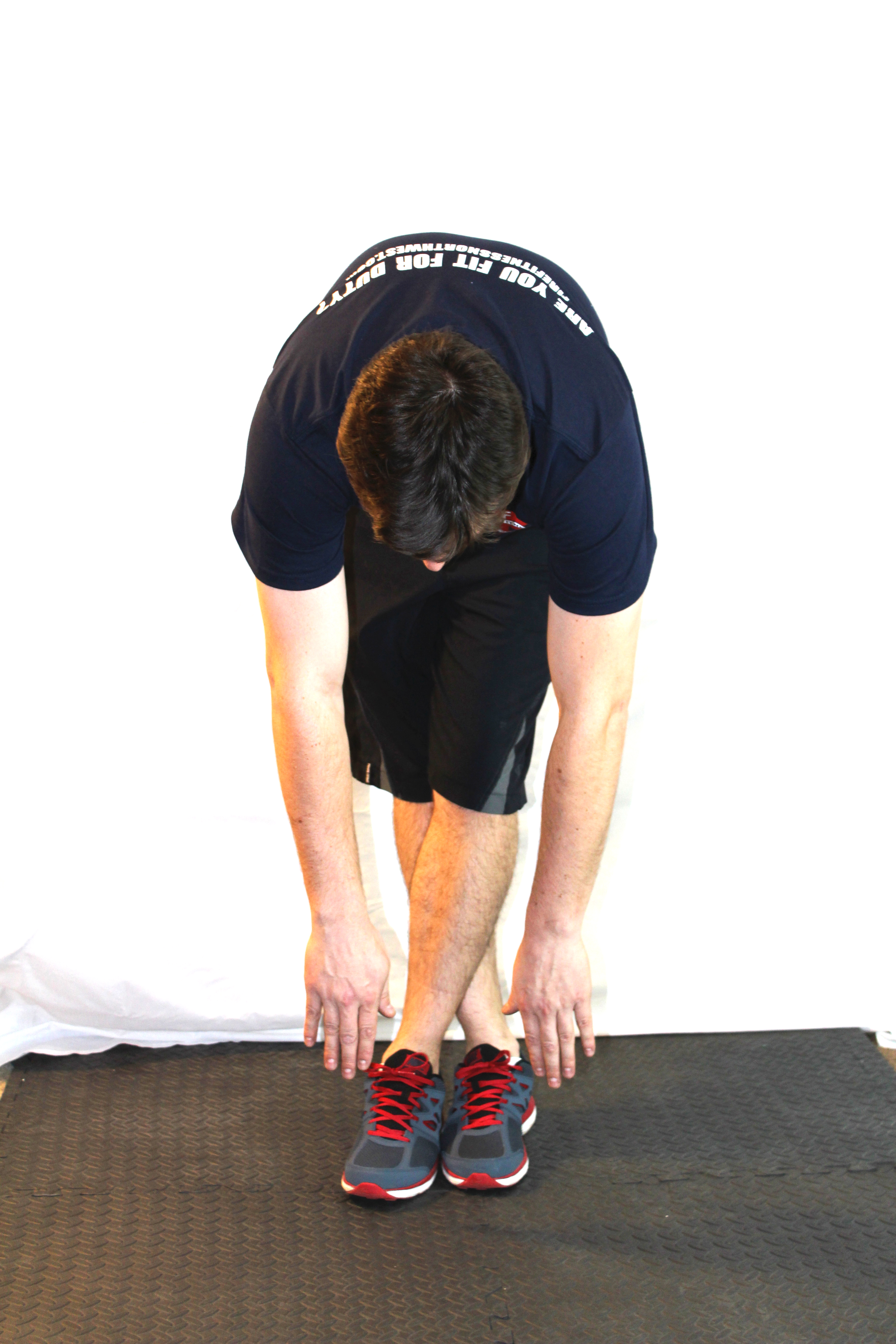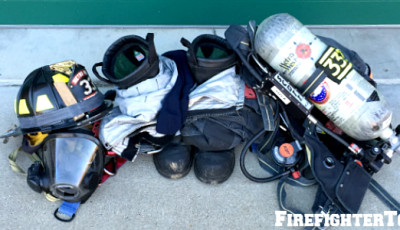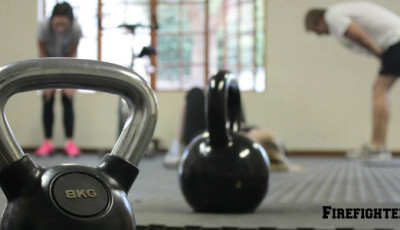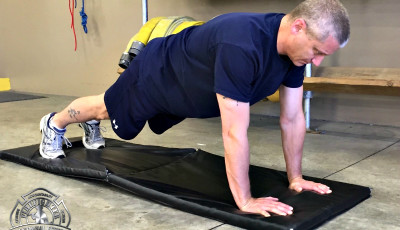5 Exercises FF Should NOT Do & What To Do Instead – Part 6
As it turns out, the top 5 exercises that I am recommending firefighters do NOT do are all because they are potentially damaging to the spine.
This is important because, by far and away, the most common area of injury to firefighters is the back. Furthermore, these tend to be the most debilitating to firefighters, sometimes even resulting in early retirement.
The last exercise in this series that may not be the best idea is a standing hamstring stretch seen in the picture above. Now, don’t get me wrong, it is EXTREMELY important for firefighters to stretch their hamstrings in order to reduce risk of back injury. However, when you stretch your hamstrings it’s best to isolate them and leave your back out of the equation.
See, when you fold in half to stretch the hamstrings, about 60% of the stretch you are feeling is actually coming from the hammies while 40% is coming from the back. While it is a good idea to do light stretches for the back, this is not the ideal way because it involves flexion of the spine.
As I’ve discussed in my earlier posts, spinal flexion places a backward displacing force on the intervertebral discs (the squishy disc in between two vertebrae) that can promote a herniated disc over time. This is also the case when sitting and folding over the waist, but not quite as bad since standing causes gravity to place even more force on the back.
Therefore, the best way to stretch the hamstrings is by lying down and propping a leg up on the wall. You’ll need a corner or doorway so your other leg has room to remain relaxed. See the picture below. Try your hardest to relax. Hold this on each side for at least 30 seconds, preferably a minute. You will get the best results if you do this 3 times per week being sure you are warmed up first. As you become more flexible, begin to scoot closer to the wall.
Read the complete series here:
5 Exercises FFs Should NOT Do & What To Do Instead
Part 1: Introduction
Part 2: Extensions & The Superman
Part 3: Sit-Ups & The Plank
Part 4: Calf Raises & Box Jumps
Part 5: Extreme Twists
Part 6: Hamstring Stretches












I would like to preface this comment by saying that I truly appreciate this site and the good intentions of all of those involved in publishing the material. Having said that, I respectfully disagree with this series.
The author states “As it turns out, the top 5 exercises that I am recommending firefighters do NOT do are all because they are potentially damaging to the spine.
This is important because, by far and away, the most common area of injury to firefighters is the back. Furthermore, these tend to be the most debilitating to firefighters, sometimes even resulting in early retirement.”
This is, without a doubt, a very valid concern. Having said that, advising firefighters not to perform exercises that involve spine loading or twisting is, in my humble opinion, counterproductive considering the nature of the job we do.
As per my department statistics, 2/3 of all the on the job injuries are to the lower back during EMS incidents. In other words, lifting HEAVY patients and equipment while on an uneven surfaces. Given this data, I strongly believe that rather than trying to avoid all loading and twisting, the goal should be to educate the troops and develop programs that mimic the demands and reality of the job.
The author states: “So don’t voluntarily load up your spine! If you’ve got to do it when wearing your gear and pack then avoid it otherwise!”
If our only exposure to spine loading activities is carrying our SCBA during emergency incidents, proficiency and comfort will never be achieved. On the fire ground, activities such as ladder throwing, hooking ceiling and roof ventilation amongst others, require a great deal of strength and flexibility. Not to mention the fact that there is more spine twisting while flowing a line that you could ever mimic on a gym setting. Firefighters are expected to perform them in less than ideal scenarios. I don’t think that completely avoiding spinal loading would prepare us for the job at hand.
I am sure there are many accidents and injuries during training exercises in military facilities or at the shooting ranges for Law Enforcement officers. Yet, it is unlikely that the approach on the part of those organizations would be to suggest Military and Law Enforcement personnel limit all shooting to fire fights or combat situations.
If the goal of the training program you choose to adopt is injury prevention, consideration should be given to strength development, proper bracing and spinal stabilization and mobility as requirements, rather than just the overall avoidance of stress to a certain body area.
I can see your point. It sounds like what you’re thinking is that if a joint/tissue is never subjected to any stress, that joint won’t be prepared to withstand the forces involved in physically demanding work like firefighting. That idea is definitely true. The thing is, during any exercise/training activity that involves muscular contraction, the intervertebral joints in the spine are being stressed because muscular contraction by the muscles that attach to the spine exerts force onto those bones. Especially if the activity is one that requires use of the core muscles to brace the torso – which is almost any motion from a bicep curl to a bench press to a hose pull – there are forces exerted onto the spine.
Biomechanical studies clearly demonstrate this to be true along with the fact that excessive flexion, hyperextension and twisting involved in these 5 exercises places forces on the joints that exceed a healthy level of stress. Therefore, over time they can promote an accumulation of micro-trauma that lowers the failure threshold of the spine and increases risk of injury on the job. Just because you have to subject your spine to excessive twisting at a fire scene doesn’t mean it’s something that you want to subject your spine to in your training – that is what would be counterproductive.
Regarding SCBA’s, my assumption was that you’re doing training activities with your gear, so your spine has adapted to those forces before you’re at a real fire. So that may be a difference in departmental operations. As you pointed out, you do want to use your training to try and mimic the physical demands that you’ll be subjected to in a real emergency. However, the calf raise machine wouldn’t serve that purpose because it would subject a compression force on the vertebrae that is MUCH higher than that of your SCBA.
I did provide a little discussion about exerting an appropriate amount of force on the spine – enough to stress the joint without causing undue damage – in part 5 of this series when I recommended light twisting during exercises like medicine ball twists rather than excessive twisting (which make the exercise less effective anyhow).
Unfortunately there is very little experimental research to understand the relationships between fitness and injury risk in firefighters (most of what you hear are assumptions). What we do have a good handle on are the ways that firefighters slowly lower their injury threshold due to repetitive, damaging forces like I’ve described.
You would have to be sedentary to avoid stressing certain parts of the body, ie: the spine. This article was directed toward firefighters who are active but are unknowingly doing exercises that can increase their injury risk. I can’t always include all the information that I’d like, since I have to keep the articles brief. So thanks for giving me the opportunity to provide more explanation!